All you need to know about your products!

| 3DNews Vendor Reference English Resource - All you need to know about your products! |
||||||
 |
||||||
|
|
||||||
Cooler Gigabyte GH-PCU21-VG (3D Cooler)Author:Date: 03/02/2004
IntroductionIn the year 2003, the industry of cooling devices made a big leap forward. Cooler manufacturers were able to solve the problem of adequate cooling of processors and began drawing more attention to other factors like noise levels, installation convenience and exterior. Of special mention is the success of Zalman which initially produced the CNPS-7000 (-Cu и -AlCu) cooler, model followed by the improved CNPS-7000A version. This product sports an impressive cooling efficiency with a very low noise level. Besides, it is easy to install on all the popular platforms (SocketA, Socket478 и Athlon 64) and offers a speed regulator. However, Zalman 7000-Cu is not a champion at cooling: this title is lost to Thermalright SP-94 radiator. The cause of the victory is in the use of "heat pipes" that are able increasing the efficiency of air-cooled radiators. At the very end of 2003, a new cooler emerged on the market: - Gigabyte 3D Cooler. No doubt, that was a marvelous marketing move: it's been a long time motherboard manufacturers ignored the cooling systems. The only what we can recall is equipping MSI boards with coolers and the release of a very popular (in its time) Asus FSCUG9C-6FC cooler. As we found out then, Asus was not the direct manufacturer of the cooler - it simply delegated its production to OEM partners. But the way Gigabyte behaved now is not quite clear: presumably, the company ordered it to the OEM suppliers or established own division for the manufacture of cooling devices. The latter option is even more likely to happen, since it's no secret that the manufacture of various computer accessories brings fantastical profits. 3D Cooler Package BundleAnyway, the cooler is there in our test lab, and we'll be testing it thoroughly enough :). First off, look at the packaging: it is made of transparent plastic with numerous cardboard inserts. 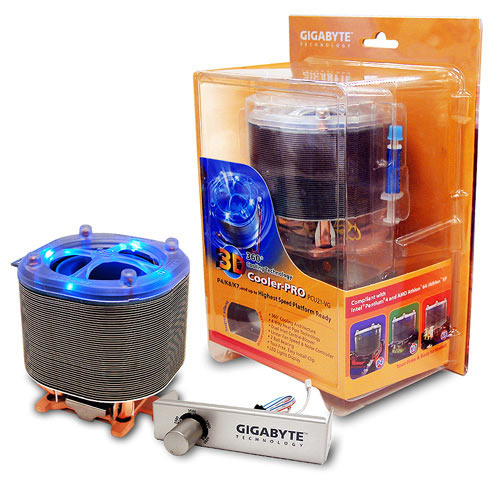
Inside the box, there are lots of various components. 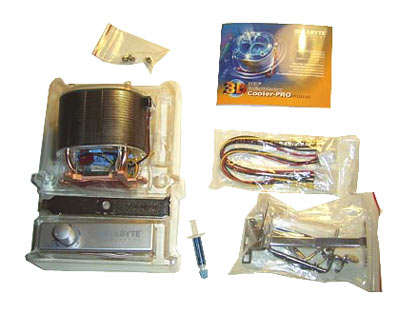
The foreground in the package bundle is the user's manual. This is no wonder though: cooling systems sometimes offer intricate shapes and are difficult to install without pictorial guides. Anyway, installation of the Gigabyte cooler is intuitive, and you can get by without a setup guide. 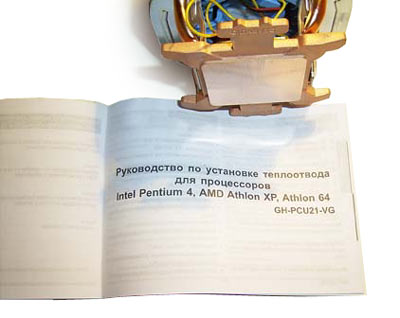
Then there goes Gigabyte's proprietary thermal paste (we'll estimate the efficiency later on) and the cooler itself. 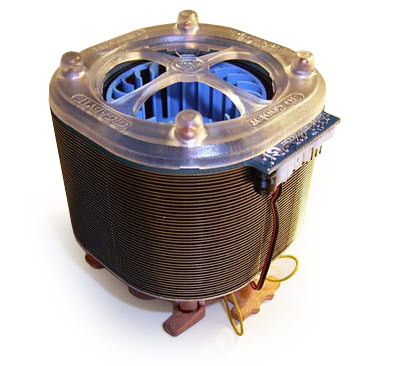
3D Cooler DesignOn to the fastening. To install the cooler on a Pentium 4 motherboard, two metals clips hooked up by the socket plastic frame are used. As regards the Athlon 64 motherboards, we were unable to estimate the fastening effectiveness: although there are many boards getting dusty in our lab, we were unable to get the right processor. And things with the fastening on a SocketA board is much simpler in all senses: the relatively small weight of the cooler allowed developers to apply a fastening clip with 6 hooks by the socket teeth. 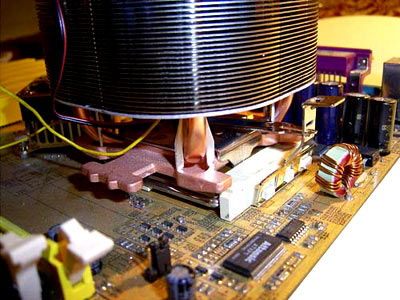
As a result, the cooler can be installed on practically any SocketA board; with the exception of those boards where capacitors of the power supply module are positioned too close to the processor socket. In this regard, Gigabyte 3D is more friendly to the use than even Zalman 7000A. As the inquisitive reader recalls, the Zalman cooler is fastened to the board that should have assembly holes on the sides of the socket. And most motherboard manufacturers give up making the feature. Therefore, the cooler can be installed trouble-free on only a few motherboards (e.g. - Asus A7N8X rev2.0). Although many motherboards have assembly holes, you have to shorten Zalman 7000A cooler and the fastening clip (with a hack-saw :) to install it . Thus, in upgrading to the Socket 754 platform this cooler becomes useless. Therefore, installation of the Gigabyte 3D cooler is very simple and performed without an issue. The only thing left is that the fastening clip for the SocketA platform does not have a fixed position, so the cooler might get fitted at a small warp. Example: 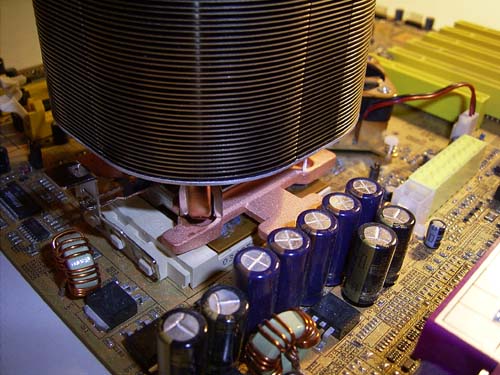
This is very easy to avoid - make the clip run right through the center of the socket. As regards the fastening on the Socket 754, it is effected with a longer clip that has a plastic fixing lever. Finally, installation of the cooler on a Pentium4 is effected with two metal clips. 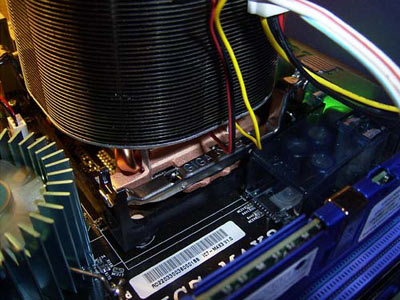
In fact, the fastening means if the only technical issue which makes Gigabyte 3D similar to the remaining coolers. In all the other respects, this is an absolutely unique creation :). Anyway, upon a closer look we see that Gigabyte engineers haven't created anything new. Let's run through it step by step: the heat generated by the processor is intensely absorbed by the thoroughly polished copper base. 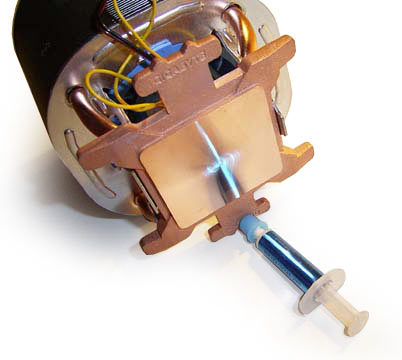
The processing quality of the base is 9/10. To prevent it from scratches, there is a sticker. 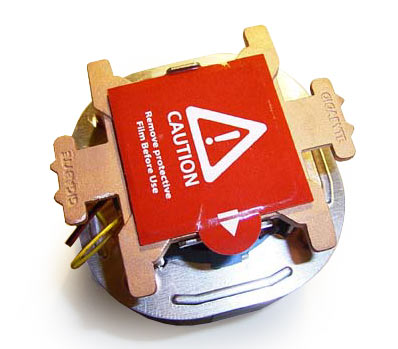
Then the heat is quickly transferred through two heat pipes. And the pipes are bent so that the heat is passed over to both ends (i.e., visually we see four pipes :). As a result, their efficiency goes up. But the pipes themselves can't transfer heat to the ambient environment (very small surface area). So approximately 50 thin aluminum plates are put on the pipes thus repeatedly increasing the surface area. Therefore, the total mass of the cooler is small - merely 430 g. In fact, this allows transporting the CPU unit without removing the cooler (with Zalman 7000A, I did that very carefully). 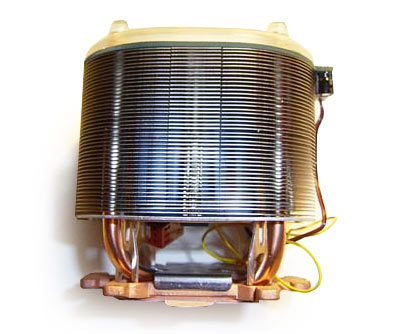
However, the great surface area is not a guarantee of high efficiency. It's the heat conduction of the heat-pipe contact and the radiator fin that plays the big part. At that, we are in for a disappointment: the contact is "dry" - that is, no thermal paste is used. So the design of GH-PCU21-VG(3D Cooler-Pro) cooler deserves a firm 4+. Now let's look at the fan. 
This is in fact a turbine, the same as that on Cooler Master Aero 7. The differences are about the direction of air flow. The turbine of the 3D Cooler-Pro is positioned in the center of the radiator, and the air comes out into all the sides (to put it right, the direction of air flow is 360 degrees; probably that's why the cooler got the postfix "3D"). The air into the turbine is sucked from both above and below. The air circulation in the bottom part favors the cooling of the base. 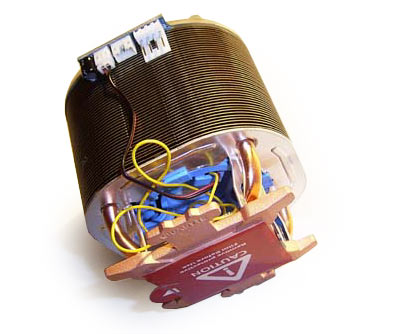
The power supply of the turbine is arranged in a quite nonstandard way: instead of the regular 3-pin connector, a small 4-pin Molex connector is plugged to the turbine (the one like this is used for powering 3" floppy drives). Such a scheme is used mainly because of the high power consumed by the turbine and not all motherboards are able providing sufficient power. 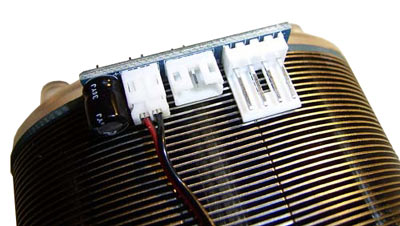
In this regard, the cooler resembles Aero 7. Another similarity is in the rotational speed regulator (plugged in to the central connector). The rheostat allows smoothly varying the speed within 2000RPM to 4000RPM. This regulator is installed on a 3-inch cap which can be installed into a respective compartment of the PC housing. 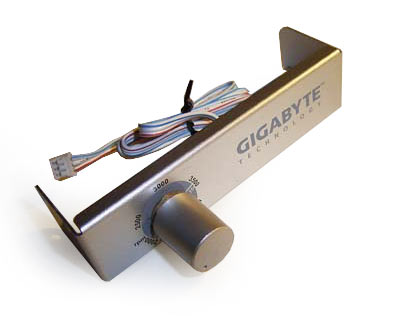
Besides, there is a cap for the rear panel of the housing (i.e. instead of one of the expansion cards). Such an approach has practically become standard among the manufacturers of high-end coolers. Recall Cooler Master Aero 7 and Thermaltake Volcano 11+. But specialists at Gigabyte added one trifle: all over the handle circle base RPM values are applied. Therefore, the user can approximately determine the rotational speed without resorting to system monitoring utilities. As the rotational speed varies, the noise level changes (from 19.2 dBA to 37.2 dBA). Frankly, there is something fishy in the minimum noise level declared by the manufacturer. The coolers Igloo Silent Breeze and Zalman 7000(A) that have been to our test lab demonstrated that with the declared 19-20dBa noise level the cooler can't be heard at all. I fear the phrase "the cooler almost can't be heard" is poorly informative, and many users interpret it in various ways. We imply it to be as follows: to make a cooler that "can't be practically heard" audible, we should do away with the noise coming from other system components (CPU unit, video card, hard disk). And only in this case we can hear the cooler from a very close distance (~10 cm). As a rule, this is simply soft rustling of the air, but if the manufacturer reduces the cost of the design, then rotor noise may rise (for instance, Igloo Silent Breeze II cooler). Unfortunately, the Gigabyte 3D at the minimum speed makes quite a noise; louder than the declared 19.2 dBa. As the rotational speed is increased to the maximum, the cooler noise starts interfering with the operation (but it's anyway quieter than CU5TB and Aero7 (max)). Therefore, it can hardly be recommended to the amateurs of absolute quietness. On the other hand, the cooler can be recommended to the modding fanciers - its peculiar exterior deserves highest praise. Besides, the plastic grid on top hides four blue LEDs which impart a special stylishness to the product :) 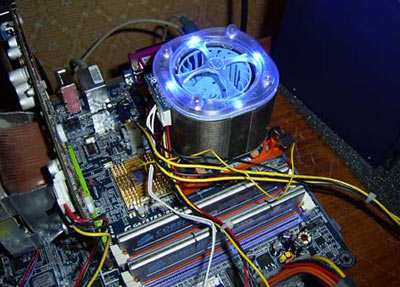
Finally, the cooler itself is of interest in terms of modifications: replacement of aluminum plates with copper (plus use of thermal paste in the contact point), which should increase the efficiency of the cooler. PerformanceSince the cooler is compatible to all the popular platforms, we are bringing in two series of tests: one for the SocketA system and one for the Pentium4 system. Of course, the cooler will take part in future tests on the Athlon64 processor platform. So, to estimate the cooling efficiency, the following test system was assembled:
We took the following coolers as the rivals for the SocketA system: CoolerMaster Aero 7 and Titan Cu5TB. Both these coolers provide for excellent cooling level and offer a completely copper radiator. Besides, Aero 7 is equipped with a speed regulator, which allows it to compete on par with Gigabyte 3D Cooler at acoustics. But for the Pentium4 system I took only two coolers: Zalman 7000A-Cu and -AlCu. In fact, these brother coolers have monopolized the market of high-end coolers of Russia (remember, they are inferior to Thermalright SP-94 at efficiency). The processor temperature and the rotational speed of the fan were measured with Motherboard Monitor v5.3.3.0. To generate a 100% load on the processor, BurnP6(for Intel) and BurnK7 (for AMX XP) were used, with domestically produced thermal paste KPT-8 used as the thermal interface. Therefore, here are the results for the Pentium4 system: 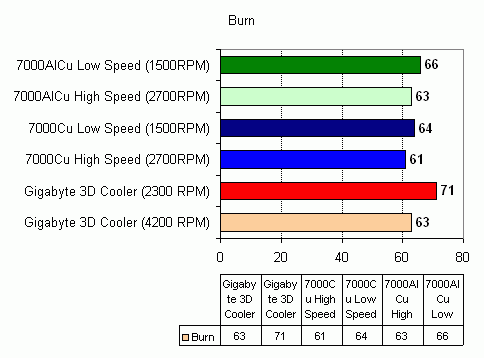
As we see, after the first try Gigabyte was unable to bring the honored grandees of the cooling industry on their knees. The thing is that at the maximum speed the noise coming from Zalman coolers is lost among other noised (PSU, video, HDD), and the noise from GH-PCU21-VG exceeds all the other noises. As regards the minimum speed, the noise from Gigabyte cooler becomes unacceptable, but the efficiency drops sharply. Now let's look at the cooling efficiency of SocketA processors. 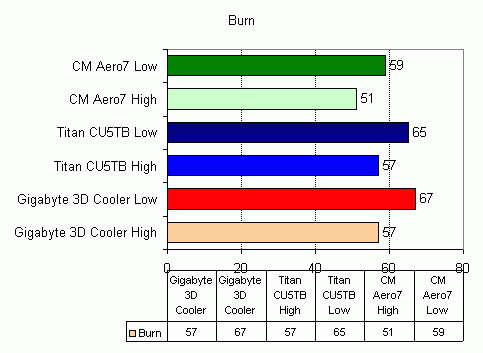
In the sector of hi-end coolers, Gigabyte 3D Cooler has given in to Aero7 at performance, but won a little at the noise level (at the maximum speed). At the maximum speed, the noise from both coolers is approximately the same. In the sector of low-end solutions at the maximum speed, 3D Cooler and Titan CU5TB showed equal performance, but the noise from Gigabyte 3D proved to be a bit lower. Final WordsSo, wrapping it all up: the most essential - Gigabyte has emerged on the market of cooling devices for the CPU. Hardly could one ever expect such an unexpected move from the traditional manufacturer of motherboards and video cards. In the recent years, Gigabyte has finally diversified its activities - recall their magneto optics, barebone systems and the serious line of network devices. This time, it's coolers. Considering the increased attention from users and media to this topic, the move is quite well-taken. The main advantages of Gigabyte 3D Cooler are its universality, small weight, excellent look and rich package bundle. The main complaint about it is the high noise level and low efficiency at the minimum speed. What remains still unsettled is the situation with the price. In any case, the cooler will enjoy keen interest among modders and fanciers of nice-looking hardware. Unfortunately, we still know nothing about the further plans of Gigabyte regarding the manufacture of cooling devices. Considering their scientific technical and financial potentials, it's quite likely that by the coming June's Computex there will be produced a new, fully copper version of a cooler offering wider range of speed regulation. Since the cooler design is basically efficient, it will have every chance to take a place of dignity among high-end coolers. ConclusionPros:
|
||||||
|
|||||